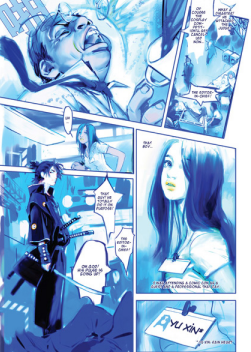When is letting go of your inhibitions worth the risk? The manhua-ka Benjamin presents two stories that delve into the human heart as well as the spirit of the artist. In "No One Can Fly. No One Can Remember" is a topsy-turvy unconventional love story between Yu Xin, someone who has abandoned drawing comics for working as a secretary, and a young man she meets at a comic con who only lives to create comics that no publisher will touch. The second story, "That Year, That Summer," follows a young man who attends an art college and falls in love; his story coincides with the dark tale of a man from the sticks looking to succeed in making art even when everyone and everything around him is dragging him down and beating him up. Each story is followed by an afterwards by Benjamin himself. Remember is a collection of stories with full color art and wider than usual pages that will set itself apart from other Asian comics.
Overall:
The one-volume Chinese manhua Remember is part of a series of full-color comics being released by Tokyopop. With all pages colored, a bigger format, and a slightly higher price, is it worth it? That depends on what you are looking for from it as a reader. It's not a full-blown series so you would not have to commit if you don't like it, but for a one shot, it should be able to satisfy as well as a multi-volume series. Sadly, the stories themselves are very weak. The first story, at its core, is about an angry young man who draws comics and the off-kilter girl who falls in love with him. There are some good ideas, like an unlikely commentary on forgery in Chinese comics and animation (surprisingly relevant to recent news about Chinese cartoonists ripping off Japanese anime) and the ending, in which the young artist makes his mark on the city with his art in a big way. Other than that, it reads like a typical melodramatic love story with no real heart and a lot of hokey dialogue and action; even Benjamin admits in his afterward that it is "half-lived and half-invented". The second story is slightly better, with a good balance between a romantic sub-plot and the troubled life of a reclusive artist who eventually goes insane. It would have been better had the needless romantic scenes been cut down somewhat, but the atmosphere of the student resident building and the story of the unloved artist is enough to make the second half of the book a worthwhile read.

The story is a downer in quality, but the art more than makes up for any faults. With a wonderful watercolor style, Benjamin uses differing palettes of colors between different scenes to create moods and atmospheres in ways words simply cannot. His art has a vibrant soul that flows through every page and makes every character a unique part of the story. His use of shading is brilliant, especially since so many scenes are dark and intimate and demand a darker look to them. It is a shame, however, that Benjamin's beautiful art does not extend to his storytelling skills. He has good ideas and has flashing moments of brilliance, but he is forced to hide his so-so stories with his artwork. It's good for him that his art is phenomenal. Does anyone want to buy a book only for its art? It's all up to the reader if they want to spend fifteen dollars on what may be for many just an art book; some readers may truly enjoy the stories, and like the drama and action that unfolds inside its pages. If readers give it a try, they will not find a masterpiece, but they will not be disappointed. Everyone will find something they will like, but it's up in the air if there will be someone who likes everything. Still, Remember is not a terrible book – it's just there, and looking mighty beautiful.
ComicsOnline gives Remember 3 out of 5 rebellious young comic artists.





